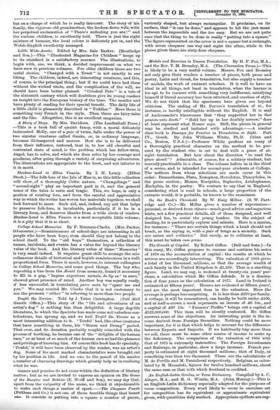Models and Exercises in Unseen Translation. By H. F. Fox,
M.A., and the Rev. T. M. Bromley, M.A. (The Clarendon Press.)—This is likely to be a very useful volume. Messrs. Fox and Bromley not only give their readers a number of pieces, both prose and poetry, Latin and Greek, for translation, but also supply a number of models, the work of eminent scholars. It is well to have an ideal in all things, not least in translation, when the learner is too apt to be content with something very indifferent, satisfying himself if literal accuracy has been attained, and careless of style. We do not think that the specimens here given are beyond criticism. The ending of Mr. Purves's translation of xi., for instance, is hardly intelligible without the English. It is said of Andromache's kinswomen that "they supported her in that passion unto death." " Held her up in her deathly sorrow," does at least represent what Homer says. Still, the pieces in general may be studied and imitated with advantage.—A. similar class book is Passages for Practice in Translation at Sight. Part IV., Greek. By John Williams White, Ph.D. (Ginn and Co., Boston, U.S.A.)—Professor White prefixes an essay of a thoroughly practical character on the method to be pur- sued by the student who is set to deal with a piece of at- sight translation. But how about the direction " to read the piece aloud" ? Admirable, of course, for a solitary student, but scarcely practicable in a class. The volume before us is the third of a series, and is intended for second-year students at College. The authors from whom selections are made occur in this order : Demosthenes, Plato, Xenophon, Herodotus, Thucydides, in the prose section ; Homer, Euripides, Sophocles, Aristophanes, ]schylus, in the poetry. We venture to say that in England, considering what is read in schools, a large proportion of the extracts would, it is probable, be known to the examinees.


















































 Previous page
Previous page